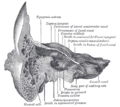| Carotid canal | |
|---|---|
 Left temporal bone. Inferior surface. ("Opening of carotid canal" labeled at center left.) | |
| Details | |
| Part of | Temporal bone |
| System | Skeletal |
| Identifiers | |
| Latin | canalis caroticus |
| TA98 | A02.1.06.013 |
| TA2 | 651 |
| FMA | 55805 |
| Anatomical terms of bone | |
The carotid canal is a passage in the petrous part of the temporal bone of the skull through which the internal carotid artery and its internal carotid (nervous) plexus pass from the neck into (the middle cranial fossa of) the cranial cavity.
Contents
- Anatomy
- Boundaries
- Relations
- Contents
- Clinical significance
- Other animals
- Additional images
- References
- External links
Observing the trajectory of the canal from exterior to interior, the canal is initially directed vertically before curving anteromedially to reach its internal opening. [1]


